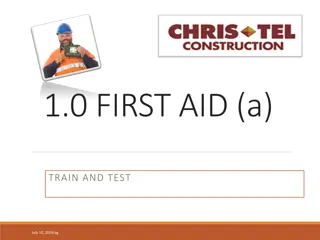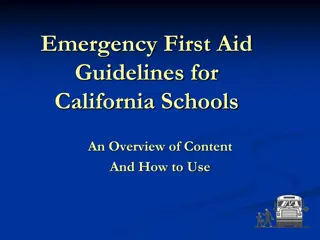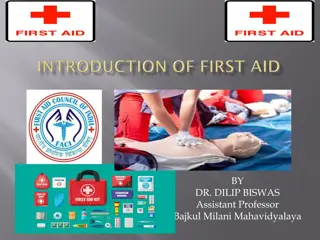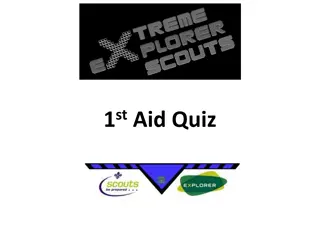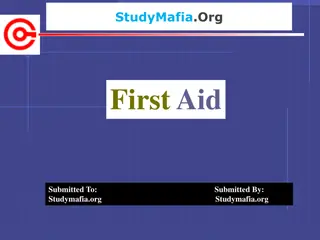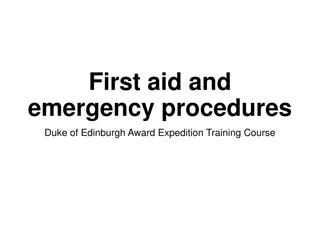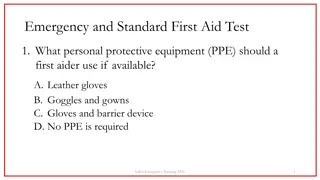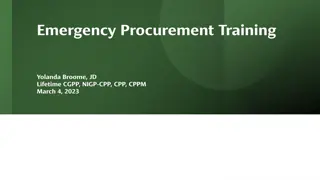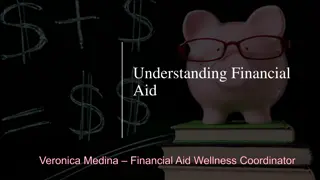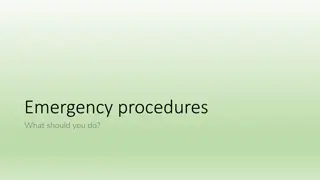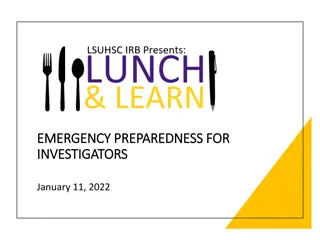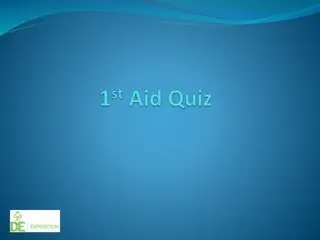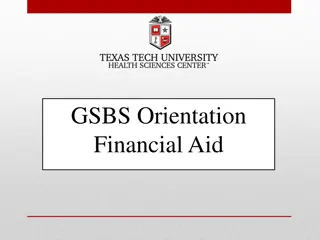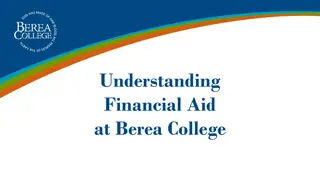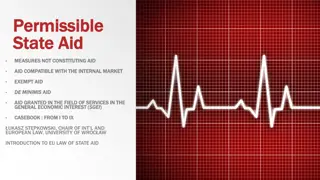First Aid Guidelines and Procedures for Emergency Situations
Learn essential first aid procedures including checking the scene and victim, calling for emergency assistance, when to dial 911, providing care, managing choking victims, and dealing with severe bleeding. Follow these steps to assess situations, administer aid, and ensure the safety and well-being of individuals in need of immediate help.
Download Presentation

Please find below an Image/Link to download the presentation.
The content on the website is provided AS IS for your information and personal use only. It may not be sold, licensed, or shared on other websites without obtaining consent from the author. Download presentation by click this link. If you encounter any issues during the download, it is possible that the publisher has removed the file from their server.
E N D
Presentation Transcript
Guidelines for First Aid Check the Scene and the Victim Assess the situation and any immediate dangers to you or the victim. Never put your own safety at risk. Determine whether or not the individual is conscious. Send someone for help-call 911 Check if the victim is breathing. Treat not breathing, no pulse or severe bleeding first. Examine the individual from head to toe. Do not stop after finding one injury. Look for medical alert tag around wrist, neck or ankle.
Guidelines for First Aid Call the emergency Number or send someone to call Speak slowly and clearly Identify yourself and the phone number from which you are calling Give exact location Describe what has happened; essential details about the victim(s), the situation and any treatments given. Ask for advice Hang up last, let the person on the other end hang up first, to make sure they have all the information they need.
Guidelines for First Aid Also Call if there is A fire or explosion A downed electrical wire Swiftly moving or rapidly rising water Poisonous gas present A vehicle collision When to Call 911-call if the victim Victim is or becomes unconscious Has trouble breathing Has persistent chest pain or pressure Is bleeding severely Has persistent pin or pressure in the abdomen Is vomiting has seizures, slurred speech, or persistent severe headache. appears to have been poisoned Has injuries to the head, neck or back Has possible broken bones.
Guidelines for First Aid Give Care Monitor the person s condition. Watch for changes in the person s breathing and consciousness. Give care until help arrives. Do not move the person unless there are nearby dangers, such as, fire, poisonous gasses, or downed power lines Help the person rest comfortably Keep the person from getting overheated or chilled.
Choking Victim The Heimlich Maneuver is used when the victim is conscious and choking, but cannot breath, speak or cough. Stand Behind Victim with arms around chest 2. Place one fist under the sternum, between the ribs. 3. Cover with other hand 4. Use quick upward abdominal thrusts. 1.
Severe Bleeding Severe bleeding or Hemorrhage, can result in shock and death if not treated promptly. Try to prevent direct contact with the blood if possible to decrease the chance of transmitting infectious diseases. 1. Apply Pressure against the would with a dressing. 2. Apply bandage snuggly by overlapping gauze rolls. Pressure Bandage. 3. If bleeding does not stop, apply pressure to the pressure point, an artery near the skin surface that passes over a bone.
Internal Bleeding Signs of internal bleeding Pain, although there may be no sign of injury Symptoms of shock paleness, cold and clammy skin, rapid but weak pulse, thirst, nausea, and vomiting. Keep person calm and lying down Call 911 Turn sideways if vomiting.
Types of Fractures Fracture; a break or crack in the bone Closed Fracture; the bone ins broken, but does not push through the skin Open Fracture; when the end of a broken bone pierces the skin.
How to treat Fractures If fracture is open, stop the bleeding. Use dressings Apply pressure around the bone end that is piercing the skin DO NOT put pressure directly on the bone. DO NOT attempt to push the bone back in. Immobilize the injured area Support fracture site between hands and do not move individual, unless it is essential. Important not to move victim if there is a spinal injury.
How to treat Fractures Splint; is any rigid material that is used to keep the injured part form moving. Splints can be rigid, soft, or anatomic. Boards, folded newspaper, a pillow, a folded blanket or towel. An anatomic splint involves using another part of the body to immobilize an injured part. Like taping two fingers together.
Sprains and Strains Sprain is when ligaments or tendons near a joint are torn or stretched. Ligaments are fibrous bands of tissue that prevent the bones from popping apart at a joint. Tendons are thick strands of tissue that connect muscles to bones. Signs and symptoms; pain on movement, swelling and discoloration Strain is overstretching a muscle or tendon. Signs and symptoms; intense pain, slight swelling and difficulty moving or using the affected part.
Care for Sprains and Strains Sprains Strains Apply cold packs to the area 2. Elevate the injured part 3. Do not use or walk on the injured part if doing so causes pain. Rest the injured part 1. 1. 2. fore a back strain, apply moist heat. For other strains, elevate the injured area and apply cold packs. 3. Get medical help, especially if pain persists.
Dislocation Dislocation is a separation of the bone from its joint. Common signs are; deformity, pain, and loss of function. How to Treat DO NOT try to set the joint. Immobilize and support the affected part, as I the treatment for a fracture. 2. Apply cold packs to the injury to keep swelling down. 3. Seek immediate medial attention. 1.
Burns First-Degree Burns are surface burns in which the outer layer of the skin is reddened and painful. Second-Degree Burns extend through the outer layer of the skin, causing blisters and reddening. Third-Degree Burns damage all the layers of the skin and the tissues underneath. These burns may look gray or charred.
Apply cool water to burned area until the pain decreases. For small burns that blister, immerse in cool water then cover with a clean dressing to prevent infection. Do NOT break any blisters.
Treating Severe Burns SEEK MEDICAL ATTENTION 1. Stop the burning 2. For a long as 15 minutes, cool the burn with lots of cool water. 3. Place a clean, dry dressing over the burned area. A clean sheet may be used as a dressing. Do not try to remove pieces of clothing stuck to burn. Do not clean burned area. Do not put any ointment or medication on the burn. 4. Monitor the person until the ambulance arrives.
Treating Chemical Burns SEEK MEDICAL ATTENTION Have victim remove clothing that has had the chemical spilled on it. 2. Flush the skin with cool water for at least 15 minutes, or until the ambulance arrives 3. Call a poison control center or a doctor for specific instruction son how to treat the burn. If chemicals get in the eyes, flush with water for 15 minutes, holding the eye open. Then cover with clean , dry dressing. 1.
Electrical Shock Electrical shock is when an electrical current passes through the body. Stay a safe distance and call 911 immediately DO NOT touch a person who is in contact with an electrical current. The current will pass to you. If the main switch is nearby, turn it off 2. After you have turned off the current, start rescue breathing or CPR 3. Cover the burned area with a clean, dry dressing. 1.
Convulsions Convulsions are alternating periods of severe muscular contractions and relaxation. Steps for Treating Convulsions 1. Call 911 2. Protect the victim form injury, by moving harmful items away. 3. Do not restrain the victim. Do not put anything into the victims mouth. 4. Watch the breathing 5. If the victim is unconscious after the convulsions have ended, turn on one side and let the victim res.
Punctures with a foreign object Treating punctures with a foreign object DO NOT remove the object 1. 2. Immobilize the area and the object. 3. Seek immediate medical help.
Head Injuries Most head wounds, even minor ones, bleed heavily because of the large number of blood vessels in the head. Stop the bleeding as soon as possible. Treatment If there is no sign of serious head or spine injury, elevate the victim s head and shoulders. Otherwise, leave the victim laying flat. 2. Apply a dressing directly to the wound. 3. Get medical help. 1.
Drowning To help victim by throwing them a rescue aid, such as Floatation device Reach with a stick or boat oar DO NOT try to swim out and get them, no matter how good of a swimmer you are. Call 911 and begin rescue breathing, if needed. Caution, most drowning victims will vomit when rescue breathing is administered.
Frostbite Frostbite is the freezing of body tissue after being exposed to cold temperatures for some period of time. Treatment 1. Cover or wrap area with blanket or clothing. Keep it dry. 2. Bring person indoors if possible. 3. DO NOT massage or rub area. Immerse in warm, NOT hot, water and gradually warm. Do not permit individual to stand or sit near a stove, radiator or fire. 4. When area becomes flush, discontinue warming. Apply dry, clean bandages over area. If it is the feet, do not let victim walk. Otherwise, elevate and exercise area. 5. Seek medical Attention.
Hypothermia Hypothermia is a serious loss of body heat that causes the body temperature to fall well below normal. Signs and Symptoms Shivering, slurred speech, muscular weakness, drowsiness, and hallucinations. Condition Can be Fatal. Treatment 1. Check breathing and heartbeat, use CPR if necessary. 2. Call 911 or send for medical help 3. Bring into warm room. Remove wet clothing and dry the individual. 4. Warm the person slowly using hot-water bottles covered in towels or warm blankets. If the person is conscious, give them warm liquids that DO NOT contain caffeine or alcohol. 5. Monitor condition until help arrives.
Heat Exhaustion Heat exhaustion occurs when a person is exposed to excessive heat over a period of time. It is caused by the loss of water and salt from the body through excessive perspiration. Symptoms Headache, heavy sweating, weakness, dizziness, and muscle cramps. Skin may become pale and clammy. Treatment 1. Move to a cool, shaded area 2. Loosen or remove wet clothes 3. Cool the victim with cool, wet cloths and fanning. 4. Give glass of cool water to sip. 5. Take to the ER if individual becomes nauseated, vomit, or lose consciousness. heat exhaustion All that you should learn about heat exhaustion
Heatstroke Heatstroke is a due to prolonged exposure to high heat, it is also known as sunstroke. Symptoms Lack of perspiration. High body temperature, reddened skin, and changes in consciousness. Unconsciousness may come on suddenly or may be preceded by headache, dizziness, rapid pulse, nausea, vomiting and mental confusion. Treatment 1. Call 911 immediately 2. Move person into shaded area and remove excess clothing. 3. Place individual into tub of cool water or place cold clothes around neck, groin and under armpits. 4. Monitor condition, if skin cools and regains normal color, discontinue cooling.



